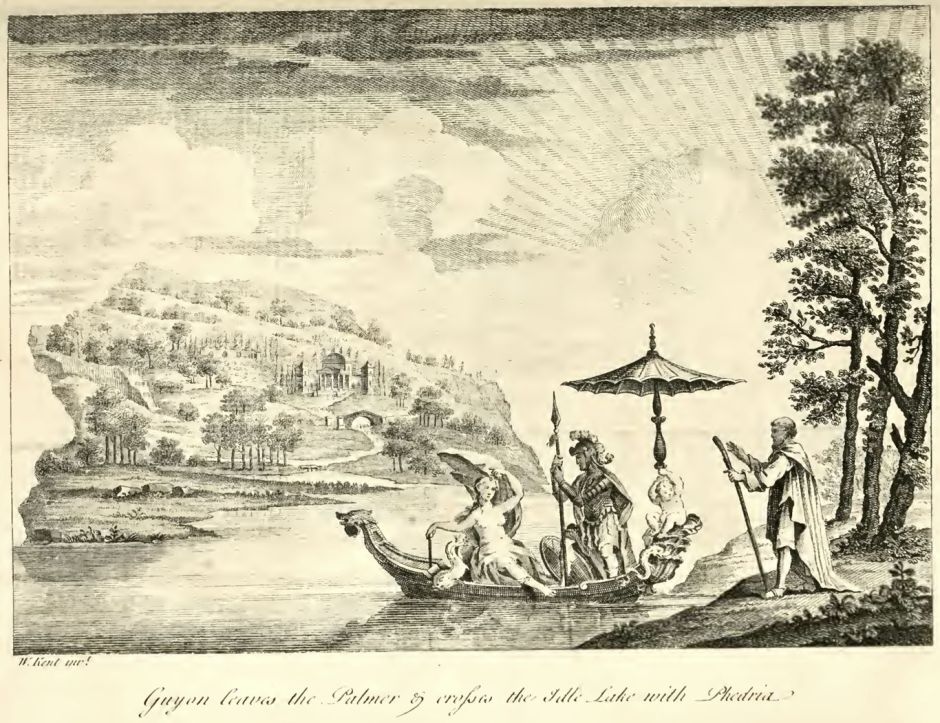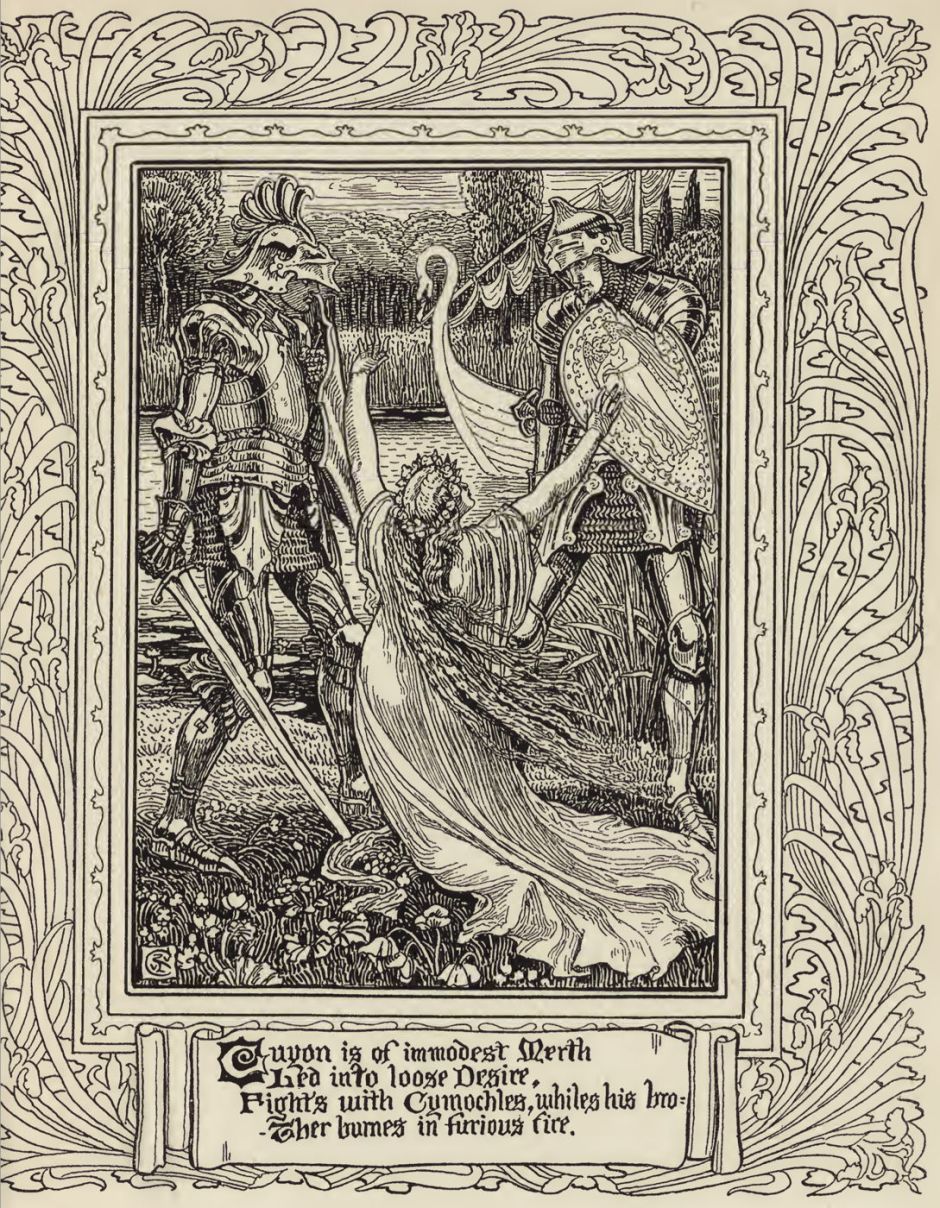In the first episode of Book 2, Sir Guyon and the Palmer continued their journey on foot, as the knight’s horse and lance had been stolen by Braggadocchio, who forced Trompart to act as his servant. The latter pair were tricked by Archimago into wreaking vengeance on Sir Guyon, but when they realised what they had let themselves in for, they fled and hid in a forest. There they were discovered by the noble huntress Belphoebe, whom Braggadocchio lusted after. When she rushed off, they made their way out of the trees, Braggadocchio riding Sir Guyon’s charger clumsily.
Canto 4
Guyon does Furor bind in chaines,
And stops Occasion;
Delivers Phaon, and therefore
By Strife is rayld uppon.
Sir Guyon and the Palmer walk on towards the sound of tumult. When they reach the scene, they discover a man dragging a youth along the ground by his hair, and beating him from time to time. Following them is an old hag who goads the man on to renewed violence towards the young man. When Sir Guyon tries to pull the old man away, the latter attacks him like a madman.

The knight falls, rises and draws his sword, but the Palmer intervenes and explains that Sir Guyon cannot overcome Furor with ordinary weapons. His first task, though, is to silence the old hag, Occasion, who is the root of all wrath. Guyon throws the hag to the ground, silences and binds her. The old man stops assaulting the youth and tries to flee, but Guyon catches him and binds him in a hundred chains. The knight then turns to attend to the wounds of the young squire named Phedon.
The squire explains that he had been tricked into believing that his noble fiancée had been unfaithful to him, and in his rage he had killed her. When he discovered the truth, he killed the false friend who had tricked him, after which he had come across Furor and the hag. The Palmer explains how the squire had allowed his emotions to grow too strong.
As they are talking, a page runs up to them, bearing a shield with the emblem of flames on a blood red background, and two darts whose tips are covered with blood and the poison of malice. Atin the page cheekily warns Sir Guyon to depart before he is in great danger from his knight the great Pyrrhochles, brother of Cymochles, both of whom are descended from immortals. He has been sent to fetch the old hag Occasion, and when Sir Guyon points the woman out, the page bursts into rage at her treatment, and throws one of his darts at the knight. He deflects it with his shield, and the page runs off.
Canto 5
Pyrrhochles does with Guyon fight,
And Furors chayne untyes,
Who him sore wounds, whiles Atin to
Cymochles for ayd flyes.
Soon Pyrrhochles himself rides up in his blood red armour, on his red charger. As he nears Sir Guyon, he brings his lance to the ready and charges at the knight. Guyon, still on foot, dodges the lance, strikes back with his sword, and cuts the head off Pyrrhochles’ horse. Its rider crashes to the ground in the pool of blood, and getting back onto his feet, he strikes Guyon’s shield with his sword. Guyon responds with a blow which cuts deep into the flesh of Pyrrhochles’ shoulder.
Pyrrhochles lashes out wildly at Sir Guyon, who bides his time until his opponent tires, then strikes him so hard that Pyrrhochles is forced onto his knees, then flat out under Guyon’s boot, where he pleads for mercy and yields. Guyon grants him that, in return for Pyrrhochles’ pledge of allegiance, and admonishment for his blind fury.
Pyrrhochles then explains that his rage had been the result of Guyon’s treatment of Furor and his mother Occasion. Guyon lets Pyrrhochles free the pair, who quickly start to attack him. When Furor gets the better of Pyrrhochles, the knight calls to Sir Guyon for help. The Palmer cautions his knight to hold back, though, as it was Pyrrhochles who wanted to free Furor and the hag. With that, Sir Guyon and the Palmer resume their journey on foot.
As they walk away, Pyrrhochles’ page goes in search of his knight’s brother Cymochles, who is to be found in Acrasia’s Bower of Bliss, reclining on lilies among half-naked young women. Atin cheekily tells Cymochles off for neglecting his brother in his need. The knight dresses in his armour and rides off at speed to rescue his brother.

Canto 6
Guyon is of immodest Merth,
led into loose desyre,
Fights with Cymochles, whiles his bro-
ther burnes in furious fyre.
As Cymochles heads towards Guyon, his road is blocked by a lake, on which there’s a gondola with boughs woven into an arbour. Inside that is a pretty young woman laughing and singing to herself. Cymochles asks her to ferry him across to the other side, which she does, but refuses to carry Atin as well. Despite its lack of oars or sail, the gondola transports them both towards an island in the middle of the lake. The damsel informs Cymochles that she is Phaedria, another of Acrasia’s servants, and the body of water is the Lake of Idleness.

Cymochles calms down, thanks to Phaedria’s playfulness and singing, and disembarks on an island in the middle of the lake, where Phaedria takes him to rest in a shady dell. She soon lulls him to sleep, and gets back into her boat.
By the time that Phaedria is back out on the water, Sir Guyon arrives on the shore, in company with the Palmer. The knight also asks to be ferried across, and Phaedria repeats her little journey, refusing to carry the Palmer despite the knight’s wishes. Guyon resists her charms, and when the boat reaches the island he is more irritated than amused by her frivolity.


As Phaedria and Guyon wander round the island, Cymochles wakes and bumps into them. Immediately, Cymochles draws his sword and attacks Guyon. They slash into one another’s armour, drawing blood from underlying wounds. This culminates in two simultaneous hammer-blows, one which cuts part of Guyon’s shield away, the other splitting Cymochles’ helmet, cutting through to his skull and knocking him senseless.

At this point, Phaedria steps between the knights and halts their fight. Guyon still insists that he wants to resume his journey, so Phaedria and her boat drop him off where it had picked up Cymochles, close to Atin. Seeing his arrival, the page first hurls insults at Guyon before running away.
A few moments later, the page is surprised to see the arrival of a knight covered in dried blood and dirt. This is Pyrrhochles, who rushes to the water and throws himself in, not caring whether he drowns. The wounded knight shouts to his page that his body is burning, and the page struggles out into the foul and muddy water.
As those two are floundering around in the lake, Archimago passes by on the shore. The page calls for his assistance, and the two of them tow the knight to the bank, where they strip him of his armour. The wizard then invokes charms and magic to undo the persistent burning in the wounds made by Furor.
Principal Characters
Acrasia, an evil enchantress who lures men to her wandering island, the Bower of Bliss. Sir Guyon has been sent to put an end to her wickedness.
Archimago, an evil sorceror who tries to stop all knights in the service of the Faerie Queen.
Atin, an insolent page (“varlet”) and servant to Pyrrhochles.
Belphoebe, a young woman who prefers hunting to being at court. Adept with her spear, and bow and arrows.
Braggadocchio, a waster and thief, prone to boastfulness, with not an ounce of honour or goodness. He steals Sir Guyon’s charger and lance.
Cymochles, an immortal knight, famed warrior, brother of Pyrrhochles, and lover of Acrasia. He has an unstable character.
Sir Guyon, hero of Book 2, “Temperance”, a knight at the Faery Queen’s court, who is sent to stop the wrongs of Acrasia.
The Palmer, an elderly man dressed in black, who is leading Sir Guyon in his quest to put a stop to the evil of Acrasia.
Phaedria, a beautiful young woman in service to Acrasia. She represents superficial and earthly pleasure.
Pyrrhochles, an immortal knight, brother of Cymochles, of fiery temper.
Trompart, a lazy and sly man who wears gaudy clothes. He becomes Braggadocchio’s servant.
References
Wikipedia on The Faerie Queene, with a partial summary
Wikipedia on Edmund Spenser
Richard Danson Brown (2019) The Art of the Faerie Queene, Manchester UP. ISBN 978 0 7190 8732 5. (Note: this isn’t about visual art, but literary art and poetics.)
AC Hamilton (ed) (2007) Spenser, the Faerie Queene, 2nd edn, Routledge. ISBN 978 1 4058 3281 6. (Critical edition.)
Elizabeth Heale (1999) The Faerie Queene, A Reader’s Guide, 2nd edn, Cambridge UP. ISBN 978 0 521 65468 5.
Douglas Hill (1980) Edmund Spenser, The Illustrated Faerie Queene, Newsweek Books. No ISBN.
Richard A McCabe (ed) (2010) The Oxford Handbook of Edmund Spenser, Oxford UP. ISBN 978 0 1987 0967 1.

